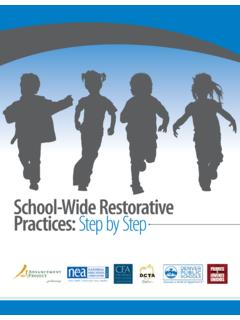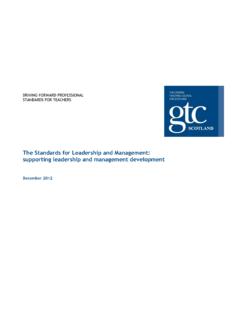Transcription of School-Wide Restorative Practices: Step by Step
1 School-Wide Restorative Practices: Step by Step Acknowledgements The Denver school -Based Restorative Practices Partnership is a coalition that includes Advancement Project, Denver Classroom Teachers Association, Denver Public Schools, National Education Association, and Padres & J venes Unidos. The content of this guide was written in working groups comprised of representatives of the partner organizations, allies in the community, and the knowledgeable staff of North High school , Skinner Middle school , and Hallett Fundamental Academy in Denver, CO. This implementation guide builds upon the first report issued by the Denver school -Based Restorative Practices Partnership, Taking Restorative Practices School-Wide : Insights from three schools in Denver, written by Yolanda Anyon, MSW, , of the University of Denver's Graduate school of Social Work. Our work has been made possible through the generous and continued support of Denver Public Schools, Colorado Education Association, and National Education Association's Center for Great Public Schools and Office of Minority Community Organizing & Partnerships.
2 It is the passionate students, families, and educators working to end the school -to-prison pipeline that will bring this guide to life. Table of Contents 2. Determining Readiness for 5. Year 3. Establishing 7. Timeline for 10. Year Two Overcoming Common Challenges to Importance of Community and Stakeholder 26. Data Collection and 30. Types of Professional Development for All 36. Tools for 38. Interview Questions when Hiring for Restorative 40. Introduction Is this guide for me? This guide is written for educators, families, and community members These exclusionary and criminalizing discipline practices are who understand that traditional, punitive discipline policies a powerful aspect of the racial inequalities that pervade public and practices are ineffective, do not support students, schooling, from disparate dropout and graduation rates, to and have a disproportionate impact on students of color.
3 Rates of referral to special education and gifted education, This guide hopes to build the capacity of educators and and differences in school funding and resourcing. Racial community members to implement a positive approach disparities are of particular concern when the disciplinary to discipline in the form of Restorative practices. category is subjective and affected by cultural perception. Restorative practices build community and promote healthy For example, suspensions for insubordination, defiance, . relationships among educators and students in order to teach the disrespect, refusal to obey school rules, and disruption . social-emotional and conflict-resolution skills necessary to reduce have been shown to exhibit very high racial disparities, and conflict. This guide provides support to any school building or have led some districts to ban them as a solution.
4 In what district looking to reform their discipline system and reduce has come to be known as the school -to-prison pipeline, racial disparities. It answers the critical question: where do we students of color are far more likely than their white peers start? This guide can also help schools or districts that have to be alienated from school through punishment, put into started along this path but are struggling with implementation. contact with law enforcement at school , and pushed towards a jail cell for the same behavior as their white peers. Why should Restorative practices be implemented? In communities across the country, school discipline policies became increasingly more punitive in the 1980s in response to the call for zero tolerance of youth behavior. The use Restorative practices build community of exclusionary discipline policies, such as suspensions, and promote healthy relationships among expulsions, and referrals to law enforcement, increased for even the most minor of offenses, like being late to school educators and students in order to teach the or talking in class.
5 Rather than support students in their development, these school policies push students out of the social-emotional and conflict-resolution skills classroom and hinder opportunities for quality education. For some students, zero tolerance means graduating high necessary to reduce conflict. school with a police record. For many others, these discipline policies push them out of school long before graduation. Rarely do these harsh practices change student behavior;. rather they actually worsen students' attitudes towards school by removing them from class and isolating them from their peers. By failing to address the adult behavior that often triggers or escalates student behavior, these practices can also damage the sense of community within a school . 2 | School-Wide Restorative Practices: Step by Step Using approaches such as dialogues, peace circles, conferencing, with assistance from the Graduate school of Social Work at and peer-led mediation, Restorative practices get to the root the University of Denver (DU); have documented successful cause of student behavior, which often relates to adult behavior.
6 Restorative practices in three Denver schools. Working together A Restorative culture seeks to address the missing piece of with school -based representatives, the Partnership is now teaching social-emotional and conflict-resolution skills by sharing the model for success with districts across the country turning behaviors into learning opportunities. Accepting that are seeking to replicate, scale, and sustain these practices. responsibility for behaviors and making right what has been Denver Public Schools' story of adopting Restorative practices wronged is the goal of the learning opportunity. Using this is undoubtedly unique. The revolutionary reforms made in model in the school community still allows each educator to Denver including an overhaul of the district's discipline have his/her own expectations and forms of accountability. policies, an agreement between the district and the police that As much as possible, students are responsible to their teachers specifies the role of officers in schools, and a statewide law that for classroom expectations and behavior.
7 When a student addresses the ineffectiveness of zero tolerance policies and does not respond to the classroom accountability system, a required schools to implement proportionate discipline were student may be referred to a support staff member for a more driven by a high-profile, racial justice community organizing intensive intervention aimed at helping the student make campaign in response to schools' reliance on out-of- school better behavioral choices. The ultimate goal in addressing suspensions to address discipline problems. In partnership all behaviors is to ensure a supportive and stable educational with the community, DPS radically changed its discipline environment while encouraging growth towards self-discipline, policies, moving away from exclusionary discipline policies accepting responsibility, and appreciating the rights of and paving the way for positive approaches like Restorative others.
8 When fully implemented with a race-conscious lens, practices. Applying over $1 million in state grants, DPS piloted Restorative practices improve school climate, increase academic Restorative practices in 2006 at one high school and three achievement and reduce racial disparities in school discipline. middle schools. The following year, the program expanded to four additional schools. The primary focus at these schools Who created this implementation guide? was a diversion program a means to refer behavioral issues The Denver school -Based Restorative Practices Partnership that often resulted in suspension, expulsion, or police referral (Partnership) is a coalition of racial justice, education, labor to the Restorative Practices (RP) Coordinator for mediation. and community groups working to ensure widespread and Instead of receiving tickets, students participated in victim- high-quality implementation of Restorative practices in Denver offender mediation practices facilitated by the RP Coordinator.
9 Public Schools and beyond. Through this partnership, the Once the funding ended, a few of the schools continued the youth and parent group, Padres & J venes Unidos; the national work by finding creative ways to maintain the program out of racial justice organization, Advancement Project; the Denver their own school budgets proving that, while outside funding Classroom Teachers Association (DCTA), Denver Public is certainly helpful and can create incentives for schools to Schools (DPS), and the National Education Association (NEA), try new approaches, it is not necessary for implementation. Denver school -Based Restorative Practices Partnership | 3. Denver is hardly alone in implementing Restorative practices Navigating the implementation Guide in schools to end punitive discipline and address racial In the Restorative practices community, it is generally accepted disparities.
10 Programs have emerged in San Francisco, that it takes three to five years to implement RP in schools, Oakland, Minneapolis, and Chicago among other cities. to shift the mindset from punitive to Restorative . As it has Best practices have been adopted from these, and other been proven successful in Denver, implementation can be models, some of which did not have access to funding as done in stages. A school or a district can start with one the pilot schools in Denver did. It is the home grown . practice and incorporate others as the school culture shifts. nature of Restorative practices implementation in Denver, This guide has been structured accordingly outlining the driven by community voices and individual school leaders, critical steps to be taken in the first year of implementation, that the Partnership has captured in this guide. how to grow in the second year, and elements to support The structure of the Partnership has ensured the sustainability of implementation.

